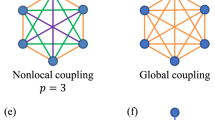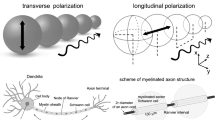Abstract
Cardiac cells are electrically coupled through gap junction channels, which allow ionic current to spread intercellularly from one cell to the next. In addition, it is possible that cardiac cells are coupled through the electric potential in the junctional cleft space between neighboring cells. We develop and analyze a mathematical model of two cells coupled through a common junctional cleft potential. Consistent with more detailed models, we find that the coupling mechanism is highly parameter dependent. Analysis of our model reveals that there are two time scales involved, and the dynamics of the slow subsystem provide new mathematical insight into how the coupling mechanism works. We find that there are two distinct types of propagation failure and we are able to characterize parameter space into regions of propagation success and the two different types of propagation failure.
Similar content being viewed by others
References
Beauchamp P., Choby C., Desplantez T., de Peyer K., Green K., Yamada K.A., Weingart R., Saffitz J.E. and Kleber A.G. (2004). Electrical propagation in synthetic ventricular myocyte strands from germline Connexin43 knockout mice. Circ. Res. 95: 170–178
Beeler G.W. and Reuter H.J. (1977). Reconstruction of the action potential of ventricular myocardial fibers. J. Physiol. 268: 177–210
Cohen S.A. (1996). Immunocytochemical localization of rH1 sodium channel in adult rat heart atria and ventricle. Circulation 94: 3083–3086
Eloff B.C., Lerner D.L., Yamada K.A., Schuessler R.B., Saffitz J.E. and Rosenbaum D.S. (2001). High resolution optical mapping reveals conduction slowing in Connexin43 deficient mice. Cardiovasc. Res. 51: 681–690
Fast V.G. and Kleber A.G. (1993). Microscopic conduction in cultured strands of neonatal rat heart cells measured with voltage sensitive dyes. Circ. Res. 73: 914–925
Guerrero P., Schuessler R.B., Davis L.M., Beyer E.C., Johnson C.M., Yamada K.A. and Saffitz J.E. (1997). Slow ventricular conduction in mice heterozygous for a Connexin43 null mutation. J. Clin. Invest. 99(8): 1991–1998
Kucera J.P., Rohr S. and Rudy Y. (2002). Localization of sodium channels in intercalated disks modulates cardiac conductiion. Circ. Res. 91: 1176–1182
Luo C.H. and Rudy Y. (1994). A dynamic model of the cardiac ventricular action potential, I: Simulations of ionic currents and concentration changes. Circ. Res. 74: 1071–1096
Maier S.K.G., Westenbroek R.E., Schenkman K.A., Feigl E.O., Scheuer T. and Catterall W.A. (2002). An unexpected role for brain-type sodium channels in coupling of cell surface depolarization to contraction in the heart. PNAS 99(6): 4073–4078
McKean H.P. (1970). Nagumo’s equation. Adv. Math. 4: 209–223
Mitchell C.C. and Schaeffer D.G. (2003). A two-current model for the dynamics of cardiac membrane. Bull. Math. Biol. 65: 767–793
Mori, Y.: A three-dimensional model of cellular activity. Ph.D Thesis, New York University (2006)
Morley G.E., Vaidya D., Samie F.H., Lo C., Delmar M. and Jalife J. (1999). Characterization of conduction in the ventricles of normal and heterozygous Cx43 knockout mice using optical mapping. J. Cardiovasc. Electrophysiol. 10(10): 1361–1375
Picone J.B., Sperelakis N. and Mann J.E. (1991). Expanded model of the electric field hypothesis for propagation in cardiac muscle. Math. Comput. Model. 15(8): 17–35
Spach M.S. (2003). Transition from a continuous to discontinuous understanding of cardiac conduction. Circ. Res. 92: 125–126
Sperelakis N., Hoshiko T., Berne R.M. and Keller R.F. (1960). Intracellular and external recordings from frog ventricular fibers during hypertonic perfusion. Am. J. Physiol. 198: 135–140
Sperelakis, N., McConnell, K.: Electric field interactions between closely abutting excitable cells. IEEE Eng. Med. Biol. 77–89 (2002) (January/February)
Thomas S.A., Schuessler R.B., Berul C.I., Beardslee M.A., Beyer E.C., Mendelsohm M.E. and Saffitz J.E. (1998). Disparate effects of deficient expression of Connexin43 on atrial and ventricular conduction: Evidence for chamber-specific molecular determinants of conduction. Circulation 97: 686–691
Thomas S.P., Kucera J.P., Bircher-Lehmann L., Rudy Y., Saffitz J.E. and Kleber A.G. (2003). Impulse propagation in synthetic strands of neonatal cardiac myocytes with genetically reduced levels of Connexin43. Circ. Res. 92: 1209–1216
Vaidya D., Tamaddon H.S., Lo C.W., Taffet S.M., Delmar M., Morley G.E. and Jalife J. (2001). Null mutation of Connexin43 causes slow propagation of ventricular activation in the late stages of mouse embryonic development. Circ. Res. 88: 1196–1202
Yeager M. (1998). Structure of cardiac gap junction intercellular channels. J. Struct. Biol. 121: 231–245
Author information
Authors and Affiliations
Corresponding author
Rights and permissions
About this article
Cite this article
Copene, E.D., Keener, J.P. Ephaptic coupling of cardiac cells through the junctional electric potential. J. Math. Biol. 57, 265–284 (2008). https://doi.org/10.1007/s00285-008-0157-3
Received:
Revised:
Published:
Issue Date:
DOI: https://doi.org/10.1007/s00285-008-0157-3




